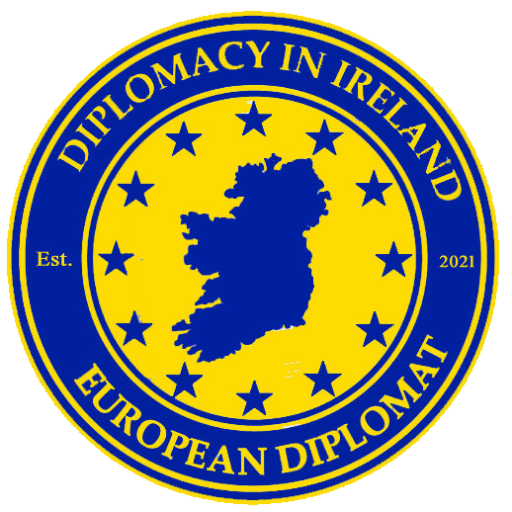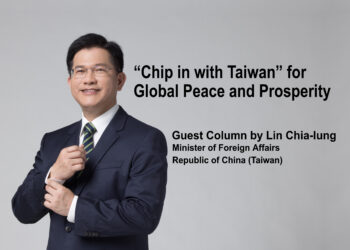by Miceál O’Hurley
and
by Oksana Shadrina
Special Ukraine Contributor
DUBLIN — Located at different ends of Europe, Ireland and Ukraine have a lot more in common than the distance suggests. Not only are there historical, cultural and religious similarities that bridge the geographical divide, but also shared challenges and opportunities offered by Brexit, the commitment of both countries to cooperation within the EU context, and burgeoning bilateral relations. The 2018 announcement by Foreign Affairs Minister Simon Coveney the Ireland is committed to open an embassy in Kyiv in would appear to affirm this. Ukrainian Foreign Minister Pavlo Klimkin’s official visit to Ireland in June 2018, the first in over a decade by a Ukrainian Foreign Minister, makes clear the two countries see significant promise in closer ties. With Brexit’s promise of chaos, and the EU’s economic sanctions against Russia for their illegal annexation of Crimea, effectively closing the Russian market to Ireland, Minister Coveney’s vision and leadership in creating more robust diplomatic ties between the two nations, and others, may prove one of Ireland’s best economic policies in decades. Indeed, the Ukrainian factor may be potentially more significant for Ireland than generally previously recognised.

Historical Ties and Parallels
Recent archeological discoveries and DNA testing have confirmed that Ireland’s earliest inhabitants originated from the area north of the Black Sea, present day Ukraine. In the seventeenth century both lands came under the rule of neighbours who sought to impose their political and cultural domination over them. Revolts, struggles for home rule, and reliance on cultural resistance, local traditions and religion to defend national identity were central characteristic for both peoples. Indeed, in the first part of the twentieth century, Ukrainians of the Greek Catholic faith living under Austrian and Polish rule in western Ukraine were often referred to as the ‘Irish of the East’. The others, the majority who remain Orthodox Christians had to endure even harsher domination by first Tsarist and then Soviet Russia.
Ireland and Ukraine both suffered from imperial cultural deprivation and exploitation. Ukrainian writers such as Nikolai Gogol (Mykola Hohol) wrote in Russian and were appropriated by Russia, while the great Irish literary figures, Yeats, Joyce, Wilde, Shaw, and Becket ‘enriched’ English literature. The tenacity and resourcefulness of the Irish inspired many Ukrainian cultural and political figures. Not surprisingly, Ireland’s 1916 Proclamation of Independence, was one of the first political documents translated into the Ukrainian language. During the First Word War and its aftermath both countries attempted to establish independent states. Ireland succeeded but Ukraine suffered a further 70 years to catch up and begin rejoining the European family of nations as the latest ‘terrible beauty’.
The cost of the struggle against imperial domination and colonisation was enormous. Both countries experienced horrendous ‘famines’, the Irish – the An Gorta Mor in the middle of the 19th century, and the Ukrainians the Holodomor of 1932-33 which killed millions. Both also witnessed a massive hemorrhaging of population, in the case of the Ukrainians not only westward, but also eastward to Siberia and the Russian Far East. For the Irish fortunate to avoid transportation to Australia, the United States and Canada were destinations of choice. Today Ireland has a huge diaspora, but Ukraine also has a sizeable one, particularly in North and South America and Russia, and more recently in several EU countries, including an estimated 5,000 in Ireland. Notwithstanding the relatively small Ukrainian community in Ireland, its people have established themselves as entrepreneurs as well as executives in some of Ireland’s largest companies and their cultural engagement in Ireland through performance groups such as the Ukrainian Emeralds. The mettle of the Ukrainian Chargé d’affaires in Dublin, Olena Shaloput, demonstrates in navigating the ever-changing political and economic climate in the face of Brexit and the Russian annexation of parts of Eastern Ukraine, has helped cement closer bonds between Ireland and Ukraine.
The EU as a magnet, agent of transformation, and platform
The EU has played a colossal role in the recent history of both Ireland and Ukraine. Ireland’s decision in 1973 to join the European Economic Community (EEC) in 1973 had a rapid and profound impact on the country’s development. It went some way in freeing it from its over-dependence on the UK market, secured huge investments to boost and diversify its weak economy, create jobs and create new infrastructure. The EU helped act as a catalyst with other partners to bring peace and political agreement in Northern Ireland through support and investment in cross-border programmes, and in so doing bolstered Ireland’s political and cultural identity as a European nation.
Ukraine had been artificially cut off from the rest of Europe by Soviet communist rule. Since President Vladimir Putin came to power, it has had to confront a residual Russian imperial mindset blocking its western orientation through political, cultural, economic and, more recently, military leverage. Ukraine has looked to the EU as not only a friend, supporter, and donor, but more importantly, as the embodiment of democratic European values and solidarity, and its natural home. During the last 15 years Ukrainians massively came out in support of European self-identification during the Orange Revolution in 2004-2005 and again during the EuroMaidan and Revolution of Dignity of 2013-2014. Russia’s response has been to seize Crimea from Ukraine and wage war in the east of Ukraine through forces masquerading as local separatists. Ukraine is the only country Europe which has already sacrificed over 10,000 soldiers and civilians, and is hosting over 1.5 million internally displaced, in the name of European values and is still losing soldiers and civilians every week because of its European choice.
Learning from Ireland’s Experience
Joining the EU, as Ireland knows only too well, is not only about reaping benefits, in other words complying with common democratic standards and rules. Ukraine, which finally concluded an Associate Partnership Agreement with the EU in 2017, is also learning that access to the EU market and visa-free travel to it is contingent on democratic transformation, ensuring the rule of law, fair play and equality, and recognizing not only the EU’s values but also regulatory influence. Ukraine is making progress in this direction, though not without delays and zig-zags. Combatting endemic corruption and the excessive control wielded by oligarchic structures remains a huge challenge, especially now as new presidential and parliamentary elections scheduled for 2019 approach. But then Ireland was also reminded by a Council of Europe anti-corruption body last year, how difficult this challenge is and how much time it realistically requires. 45 years after Ireland joined the EEC, Ireland was found to be “globally unsatisfactory”, particularly in the areas of judicial appointments and independence. Here is where Ireland could share its lessons learned and best practices with Ukraine.
Brexit, Ireland, the UK and Ukraine
Brexit, which was unexpected, has introduced new challenges for all concerned, both on the macro level concerning the terms of the UK’s extrication from the EU, and the micro, for instance, the implications for Ireland’s bilateral relations with the UK, and for the border with Northern Ireland. But Ukraine has also figured in the discussions about the consequences of the Brexit and how they could be addressed. In fact, the British government seems to see a Ukraine-style association agreement as a possible model for its future relationship with the EU, combining both ‘sovereignty’ and close economic ties.
On the surface, such a model would appear to allow the UK to circumvent unwanted obligations, whilst preserving some of the economic benefits of membership. In reality, however, Ukraine’s association agreement incorporates a “Deep and Comprehensive Trade Agreement” (DCFTA) which according to the European Commission involves an ‘unprecedented level of integration’. In exchange for deep and comprehensive market access and customs co-operation through the EU, Ukraine has to align its domestic legislation to EU law. It will have to implement 80 to 90 per cent of the acquis communautaire (the body of EU law and regulations). This incentive structure for domestic reforms within a binding legal framework is not something the UK, anxious to safeguard its sovereignty, will be prepared to return to, but these elements of the EU’s neighbourhood policy will bring Ukraine closer to Ireland and other EU members.
Brexit Promises Not only Economic Uncertainty but Opportunities
As Ireland examines how to implement Brexit, and Ukraine further disentangles itself from Russia and integrates more closely with the EU, both countries have new and much-needed opportunities to enhance trade and tourism so as to bolster their respective economies. Fortunately, promising economic and trade opportunities abound for both countries. Robust mutual cooperation between them in several sectors could significantly offset Ireland’s exposure to Brexit backlash while helping both to revitalise their own economies, and collaterally the EU’s generally. Today, Ukraine’s strong transport system and burgeoning air travel and cargo routes can bridge Ireland’s post-Celtic Tiger trade gap. This partnership offers Ireland access to much-needed imports previously supplied by the United Kingdom and in return Ukraine would have access to a new trading partner.
Exports of Ukrainian goods to the EU increased by more than 30% in 2017 alone, reaching almost €15.86 billion. Ukraine’s export of corn, sunflower oil, raw ore and steel, as well as other sundry goods make it an emerging player in the EU market. Ireland and Ukraine traded more than €320 million worth of goods and services (a 40% increase since 2016). Not surprisingly, the main exports to Ukraine were pharmaceuticals, food products, and equipment. Ireland’s primary imports included grain, ferrous metals and oil – products.
No other market immediately available to Ireland, with even a nascent history of trade, can boast of a 40% increase in a single year while promising continued near-term and long-term growth. Here are some recent inspiring examples. This month Ryanair began operating from Ukraine. Initially, it plans to fly about 635,000 customers annually from airports in Kyiv and Lviv, opening 15 new routes so far.
Meanwhile, a leading Irish construction company, the CRH Group, has successfully developed and expanded its business holdings in Ukraine with a substantial investment in stone quarries and large-scale cement production plants in Odessa, Mykolaiv (Lviv region), Kamiayanets-Podilskyi, Zhytomyr, and Bila Tserkva. And in February 2018, the Dnipropetrovsk Regional State Administration and the Irish “Altostrata” company agreed on the construction of a 250-megawatt solar power costing around €255 million.
IT and Engineering Sectors
Dubbed the ‘Data Capital of Europe’, Ireland has a strong Information Technology (IT) sector worth more than €21.1 billion (as of 2016). The IT industry employs more than 105,000 people in both local businesses and multi-national companies. Conversely, Ukraine hosts the fourth largest IT pool in the world. IT outsourcing has become Ukraine’s third largest export. An affinity between Ukraine’s inherent IT skills, literacy and advanced education, could dovetail neatly with Ireland’s role. And, while Ireland continues to undergo rapid infrastructure development, Ukraine is home to the largest engineering pool in Central and Eastern Europe (with 130,000 new graduates annually). These complimentary business sectors make a match between Ireland and Ukraine highly attractive
Agri-Sector Opportunities
Ukraine is famous for its abundant fertile black soil, with 33 million hectares of arable land (with 30% of the world share of soil banks – the largest in Europe). The country is among the leading global exporters of agricultural produce including sunflower seeds and sunflower oil, honey, and grains, especially corn, wheat and barley. Ireland’s traditional agriculture sector garnered more than €13.9 billion in 2016. The country is renowned for high quality produce, and innovative modern processing technologies from which the Ukrainian agribusiness sector could benefit

Tourism
With Visa-Free travel available to Ukrainians throughout Europe (excepting the UK and Ireland which opt-out of the Schengen Area); opportunities exist to build further cultural and social ties. In 2016, Ireland’s tourism sector was valued at €4.577 billion and is growing. Likewise, Ukraine’s tourist industry has experienced a revival. With prices still relatively low and much on offer, Ukraine offers an affordable and enjoyable opportunity for tourists. With the average tourist stay in Ukraine being four-days, with an average spend of only Six Hundred Euros per visitor, Ukraine offers Ireland a new and sought-after tourist destination at significant value-for-money. Should Ireland join the rest of Europe and opt-in to the Schengen Area post-Brexit, and with Ryanair establishing direct flights to and from Ukraine, the country could share in a potentially lucrative Ukrainian tourist market.
All changed, changed utterly

Ireland and Ukraine share so much in common in their past. Their rich cultures, developed in the most difficult of conditions, is the stuff for cross-fertilization. But it’s not only about patriotic songs, drinking habits and stirring poetry and literature. It’s about the very real new opportunities for mutually advantageous bilateral cooperation in trade, commerce, science, technology, development and tourism that have been opened up by Ukraine’s return to Europe, Brexit, and the launching of new cheap direct flights between the two countries, with help from the IT fraternities in both countries. In short, Ireland and Ukraine are poised, if not destined, to finally discover one another for their mutual cultural and economic benefit.
















































